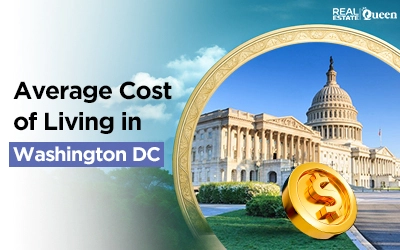
Considering a move to Alaska? With its rugged wilderness, close-knit communities, and resource-driven economy, the state draws people for many reasons. Still, the average cost of living in Alaska is higher than in most parts of the US.
Alaska’s 2025 cost-of-living index is 124.9, about 25% above the national average. Higher prices for housing, groceries, and utilities drive the difference. Knowing these expenses helps you prepare for life in The Last Frontier.
TL;DR: Average Cost of Living in Alaska 2025
- Cost-of-living index: 124.9 (≈25% above US average)
- Estimated minimum salary (middle-class, single adult): $96,429
- Average rent (all units): $1,550–$1,800/month
- Median home price: $400,500
- Average monthly utility bill: $727
- Average weekly grocery bill: $329
- Public transit pass (Anchorage): $75/month
- Healthcare: Highest average costs in US; $282–$407 avg. monthly premium (with subsidy)
- Childcare (infant annual average): $20,943
- Minimum wage: $13.00/hour
What Is the Average Cost of Living in Alaska?
Living in Alaska in 2025 means you need a minimum annual salary of about $96,429 for a middle-class lifestyle. This applies across the state, from Anchorage’s job-rich corridors to more remote interior communities.
In addition, wages are high here, but so are everyday expenses:
- Housing: $1,550–$1,800/month rent; $400,500 median home price
- Utilities: $727/month on average
- Groceries: $329/week, second highest in the nation
- Healthcare: Out-of-pocket costs often reach over $6,000/year
- Childcare: $20,943/year for infant care
For example, in Anchorage and Fairbanks, residents benefit from a broader job market but face high housing costs. Meanwhile, remote towns often experience even steeper prices due to shipping and logistics.
Housing and Rental Market in Alaska
If you’re eyeing Alaska for a fresh start, know that housing affordability remains a major challenge. The average rent statewide ranges from $1,550 to $1,800 per month. On the other hand, the median home price is $400,500, which can be a steep climb for first-time buyers.
Here’s how Alaska’s housing market compares with neighboring states:
- Washington: Rent is 25–40% higher; median home price $658,700 (+65%)
- Oregon: Rent is 10–20% higher; median home price $521,500 (+30%)
- Montana: Rent is 30% lower; median home price $528,000 (+32%)
- Wyoming: Rent is 35% lower; median home price $450,000 (+12%)
- Hawaii: Rent is 65–100% higher; median home price $975,500 (+144%)
Anchorage is the state’s largest city and main economic hub, attracting renters and buyers alike. Fairbanks offers a slightly more affordable market but has higher utilities. Meanwhile, Juneau’s remoteness causes prices to rise due to limited supply.
👉 Looking for homes for sale in Alaska that match your budget? Discover the latest listings with advanced search filters and sorting options on Houzeo, America’s best home buying website.
Utilities and Other Living Expenses in Alaska
Utilities are a big part of the average cost of living in Alaska. The state’s energy needs in winter drive the average monthly bill to $727.
Compared to peer states:
- Washington: $490/month (33% less)
- Oregon: $520/month (28% less)
- Montana: $450/month (38% less)
- Wyoming: $320/month (56% less)
- Hawaii: $780/month (7% more)
Groceries are another significant cost. At $329 per week, Alaska has the second highest grocery prices nationwide. By contrast, Washington averages $288, Oregon $249, and Montana only $246.
Transportation also plays a role. Gasoline averages $3.97 per gallon in Alaska. Public transit in Anchorage costs $75 monthly. Vehicle and ferry costs add 10–20% more than in mainland states.
Healthcare in Alaska is the most expensive in the US, with monthly premiums ranging from $282 to $407. Many residents face out-of-pocket costs above $6,000 annually.
Income and Job Market Overview
To afford the average cost of living in Alaska, you’ll need nearly $100,000 per year in salary for a middle-class lifestyle. This aligns closely with Washington state but is higher than Oregon, Montana, and Wyoming.
- Alaska’s required annual salary: $96,429
- Median household income: $91,260 – $99,684
Wages here are high but necessary. The state minimum wage is $13/hour as of July 2025. These wages help offset the cost pressures unique to Alaska’s geography and economy.
Is the Average Cost of Living in Alaska Worth It?
Alaska offers a rare lifestyle with stunning nature and close communities. However, living here comes with a 20–40% cost premium over many Lower 48 states.
With wages high but expenses even higher, life in Alaska demands careful budgeting. Only Hawaii exceeds Alaska in overall cost. However, many residents find the lifestyle and natural beauty worth the expense.
On the other hand, newcomers prioritizing affordability might consider neighboring states like Montana or Wyoming, which offer lower living costs.
Regional Insights
- Anchorage: Largest city, most job opportunities, rents averaging $1,550–$1,800, but with higher childcare and utility costs.
- Fairbanks: Offers moderate housing prices but higher utilities due to winter energy use.
- Juneau: Remote capital with elevated living costs caused by supply chain limits.
- Mat-Su Valley: Popular commuter area with more affordable housing but increased transportation expenses.
When relocating, consider these economic hubs carefully. Remote communities often face even steeper costs for goods and services.
Final Thought on Alaska’s Cost of Living
In 2025, the average cost of living in Alaska stands near the top nationally. It rivals Hawaii but greatly exceeds mainland peers like Washington, Oregon, Montana, and Wyoming.
High salaries are essential here; they are not a luxury. The state’s geographical challenges and logistics push prices higher in housing, utilities, groceries, and childcare.
However, Alaska’s unique lifestyle and natural environment make it a compelling choice for those who can manage the costs.
👉 Browse the latest Alaska homes for sale on Houzeo and match your budget with your dream neighborhood.
FAQs About the Average Cost of Living in Alaska
How expensive is the average cost of living in Alaska?
Alaska’s cost of living index is 124.9, about 25% above the US average. Only Hawaii is higher.
What salary is needed to live comfortably in Alaska?
A single adult needs about $96,429 per year to maintain a middle-class lifestyle in Alaska.
How does rent in Alaska compare to other states?
Average rent in Alaska is $1,550–$1,800 per month, lower than Washington and Hawaii but higher than Montana and Wyoming.
Are utilities in Alaska very costly?
Yes, with an average monthly bill of $727, Alaska’s utilities are 28% to 56% higher than regional states.
Does Alaska have the highest healthcare costs in the US?
Yes. Healthcare premiums and out-of-pocket expenses rank among the highest nationwide.






